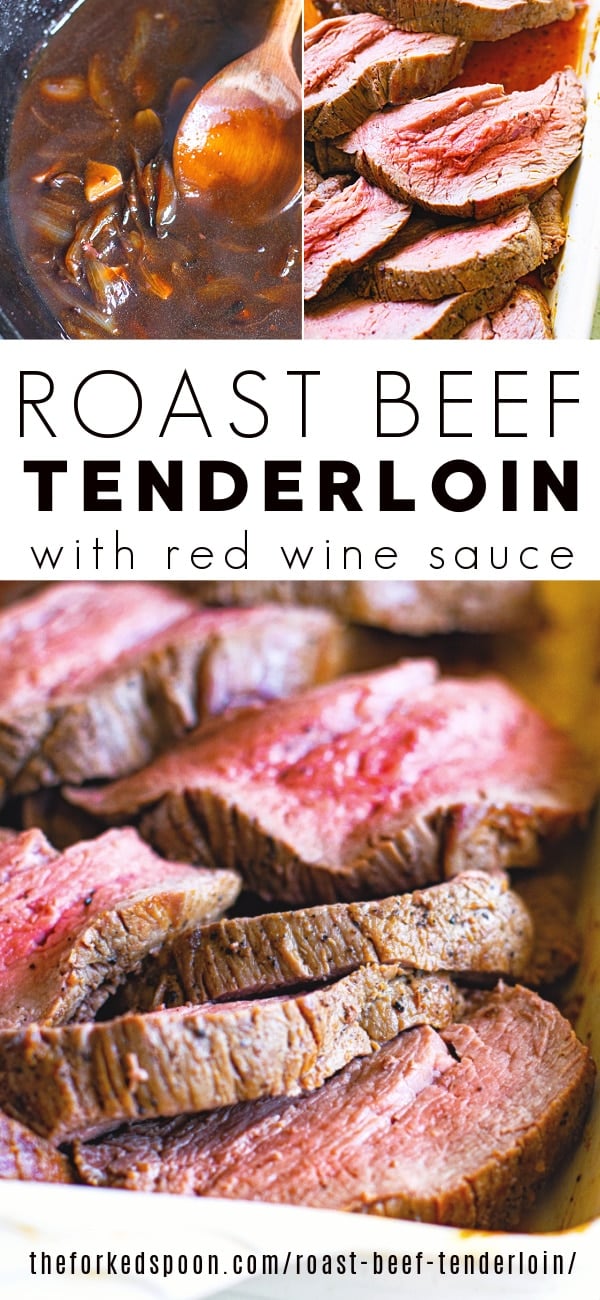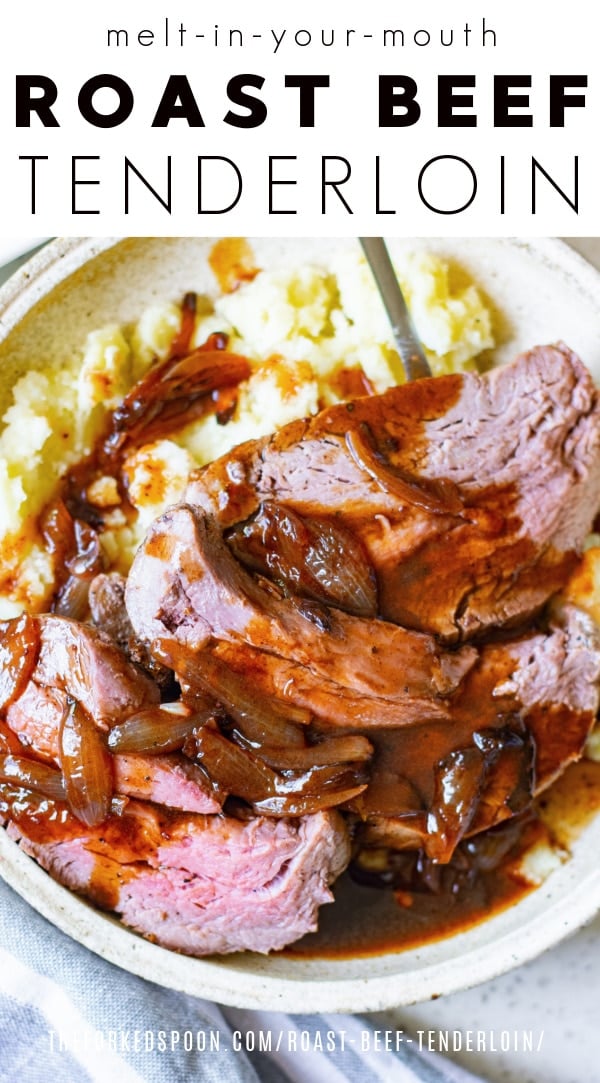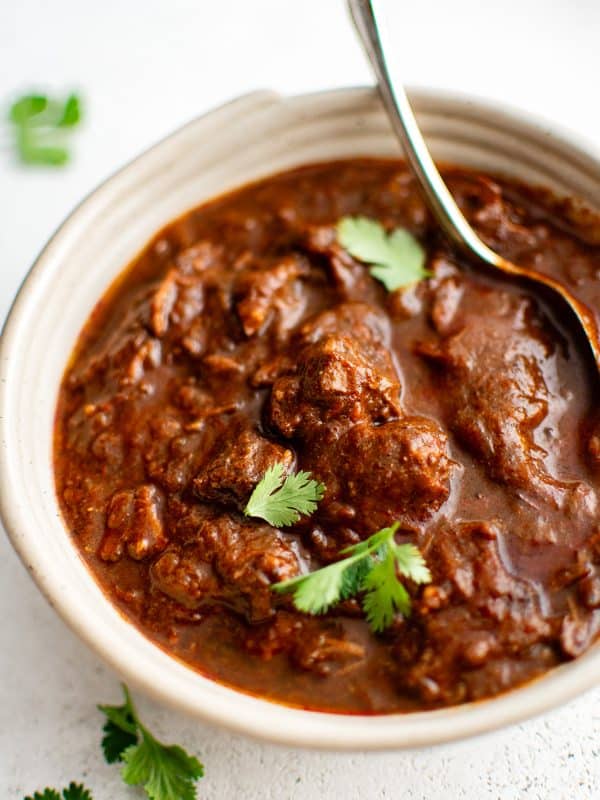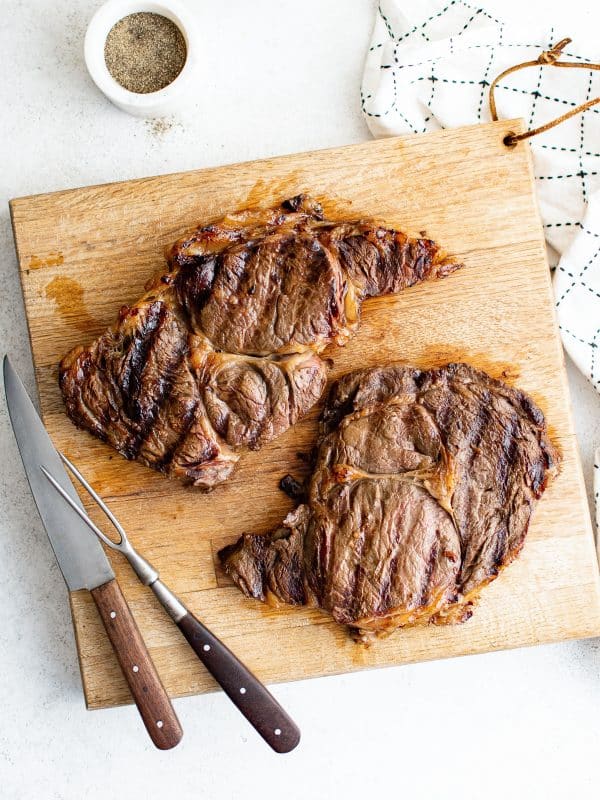This post may contain affiliate links. See my disclosure policy.
This impressive Roast Beef Tenderloin with Red Wine Sauce is melt-in-your-mouth delicious and perfect for any special occasion or celebration. Learn how easy it is to make this tender, juicy roast beef tenderloin recipe in the post below.

The Best Roast Beef Tenderloin
You’re looking for a recipe that looks incredibly fancy, tastes like a million bucks, and is secretly so easy to make that you can have a party of 10 served in little more than an hour.
This tender, juicy, melt-in-your-mouth roast beef tenderloin is exactly the recipe you’re looking for.
Naturally delicious, beef tenderloin doesn’t need a whole lot in the way of seasoning and spices, making it one of my very favorite meals to prepare for special occasions or holidays like Easter, Christmas dinner, and New Years’.
Table of Contents
What’s important to know for today?
- Today we’re roasting a whole center-cut beef tenderloin. You have the option of cutting the tenderloin in half to create two smaller roasts (say, for example, you want different seasoning or different doneness), but the images illustrate a whole tenderloin.
- Beef tenderloin is easily overcooked, so keep that digital meat thermometer handy or stick in an instant-read thermometer and remember that your roast will continue to cook after it’s removed from the oven.
- The best way to cook beef tenderloin is to first sear, then roast in the oven, which is exactly what we’re doing today.
- This recipe may look incredibly fancy and difficult, but it’s so easy! Give it a try.
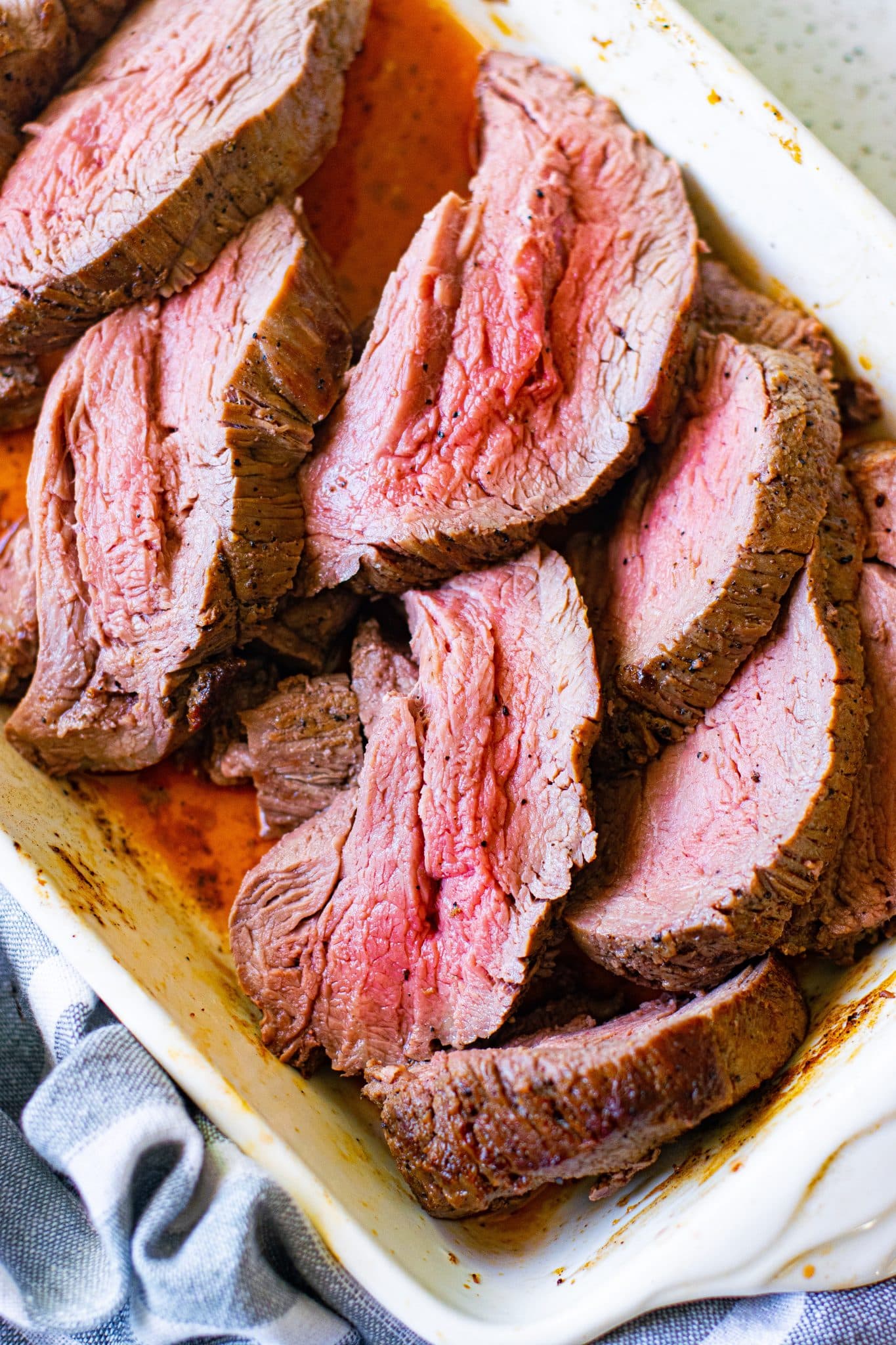
What is Beef Tenderloin?
As the name suggests, beef tenderloin is considered the most tender cut of beef. It is also the most expensive cut.
Known by many names, eye fillet in Australia, Filet Mignon in Brazil, fillet in the United Kingdom, and filet in France, beef tenderloin is an oblong muscle called the psoas major. What’s important about this muscle? It gets very little exercise, making this cut of meat tender and incredibly delicious to eat.
If fact, some of our favorite cuts of beef come from this very piece of meat including a portion of the T-bone steak and the fancy filet mignon.
When purchasing a whole beef tenderloin you may find them,
- Trimmed – more expensive with the fat and silverskin removed for you.
- Untrimmed – sold at a lower price, but left with the fat and silverskin still intact. You will have to trim this yourself.
If this is your first time preparing and working with beef tenderloin, I highly recommend purchasing a tenderloin that has already been trimmed for you (especially if you plan to serve this to a group of guests).
Common cuts include top round roast, top sirloin roast, bottom round roast, and eye of round roast.

How to Tie a Roast?
Tying your own roast appears intimidating at first, but it’s not as hard as it seems and you’ll get better and better the more that you do it. So don’t let this simple step scare you away.
When tying a whole tenderloin, look for the tapered, thinner end, and tuck it under before tying up the roast. Then use kitchen twine to tie the roast firmly, but not too tight. For best result, tie in even, approximate 1-inch intervals.
Secure the twine from end to end by making a slip knot on one end of the roast. Make a series of loops to cover the roast and cut the excess of twine.
Watch this Tying Beef Tenderloin video to learn more.

How to Make It
1. Chill overnight
If you have the time, plan to chill your tenderloin in the refrigerator uncovered overnight. Prepare it first by patting the entire surface of your tenderloin dry with paper towels. Tie it with twine and transfer it to the refrigerator.
- NOTE: Chilling overnight is completely optional. It helps get a nice, crispy crust when searing. If you skip this step, that’s ok, you’ll still get fabulous results.
2. Bring to room temperature and season
Regardless of if you chilled overnight or not, you want to remove your beef tenderloin from the refrigerator at least 1-2 hours before you plan to pop it in the oven to cook.
If you haven’t already, tie your beef tenderloin and season the surface with salt and pepper.
- TIP: Why do we bring our beef tenderloin to room temperature? It helps ensure even cooking. If the center is still cold, it will take longer to cook compared to its room temperature exterior.

3. Slather
Transfer the (room temperature) beef tenderloin to a roasting pan or baking dish and slather the outside with softened butter.
- TIP: if your beef is too cold, the butter will instantly solidify, making it hard to spread.

4. Sear
Heat a large cast-iron skillet over medium-high heat. Once the pan is hot, add a tablespoon of oil and the butter-covered beef. Sear, undisturbed, until browned, approximately 3-4 minutes. Repeat on all remaining sides.

5. Roast
Transfer the seared beef tenderloin back to the roasting pan and place it in the preheated oven.
- NOTE: Reserve the cast-iron skillet, we’ll be using that again in a minute.
Cook to your desired doneness (rare, medium-rare, or medium). It takes approximately 20 minutes to reach an internal temperature between 120 – 125 °F (medium-rare) as read using a digital meat thermometer.
6. Rest
Remove the roast and allow it to rest for about 15 minutes before removing to a cutting board to slice.

Internal Temperature for Roasted Beef Tenderloin
Always remember to measure the temperature from the thickest part of the meat.
- Rare – 115°F – 120°F
- Medium rare – 120°F – 125°F
- Medium – 130°F – 135°F
Total cooking time will vary depending on how done you like your roast. Also, note that your roast will continue to cook by approximately 5-7 degrees F after it is removed from the oven.

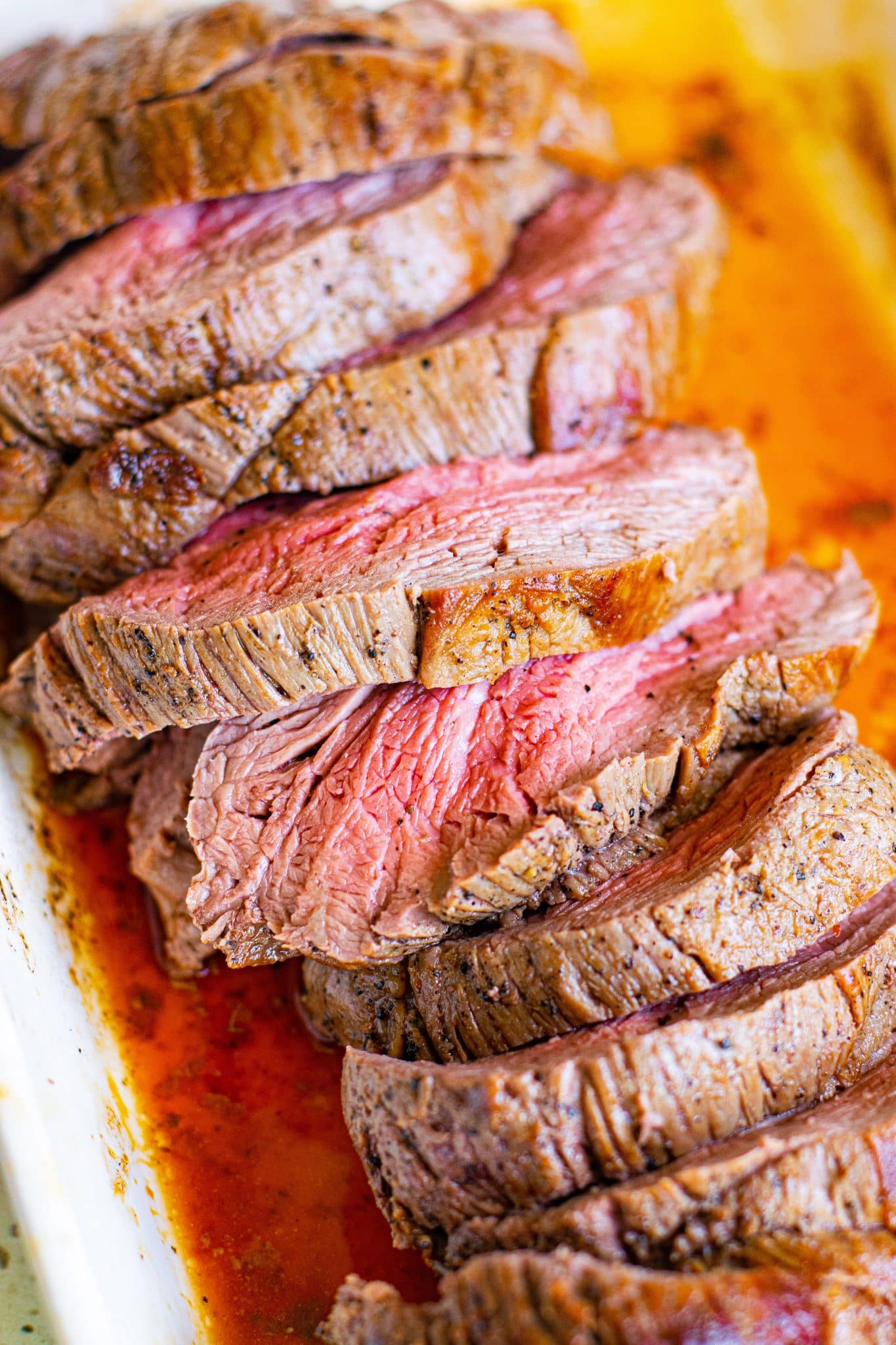
How to Serve
Roast beef tenderloin pairs really well with some kind of potato side dish and vegetable dish.
Mashed potatoes – including this Instant Pot mashed potatoes or low-carb cauliflower mashed potatoes.
Wild rice would also pair quite well given its naturally nutty taste and texture
Roasted vegetables of every kind:

Red Wine Sauce
I highly encourage you to make this delicious (and super easy!) red wine reduction. It cooks directly in the same cast-iron skillet that you used to sear your roast, so no need to give it a wash as we want all those flavorful stuck on brown bits.
Return the cast-iron skillet to the stovetop over medium to medium-high heat. Once your pan is nice and hot, add a splash of red wine and scrape off any stuck-on brown bits.
Add the olive oil and sauté the onion for about 3-5 minutes or until soft and lightly browned. Add the garlic and sauté for an additional 1-2 minutes.
- TIP: Feel free to double up on the onions or replace them with shallots, if desired.
Pour in the remaining red wine and beef broth and the fresh thyme. Cook until reduced by half.
Remove the thyme sprigs and season with salt and pepper, to taste.

More Beef Recipes
- Instant Pot Beef Stew Recipe
- Pan-Seared Steak
- Beef Stroganoff Recipe
- Garlic Butter Steak Bites Recipe
- Skillet Salisbury Steak Recipe
- Beef Tips and Gravy

If you try making this Roast Beef Tenderloin Recipe with Red Wine Sauce, please leave me a comment and let me know! I always love to hear your thoughts.
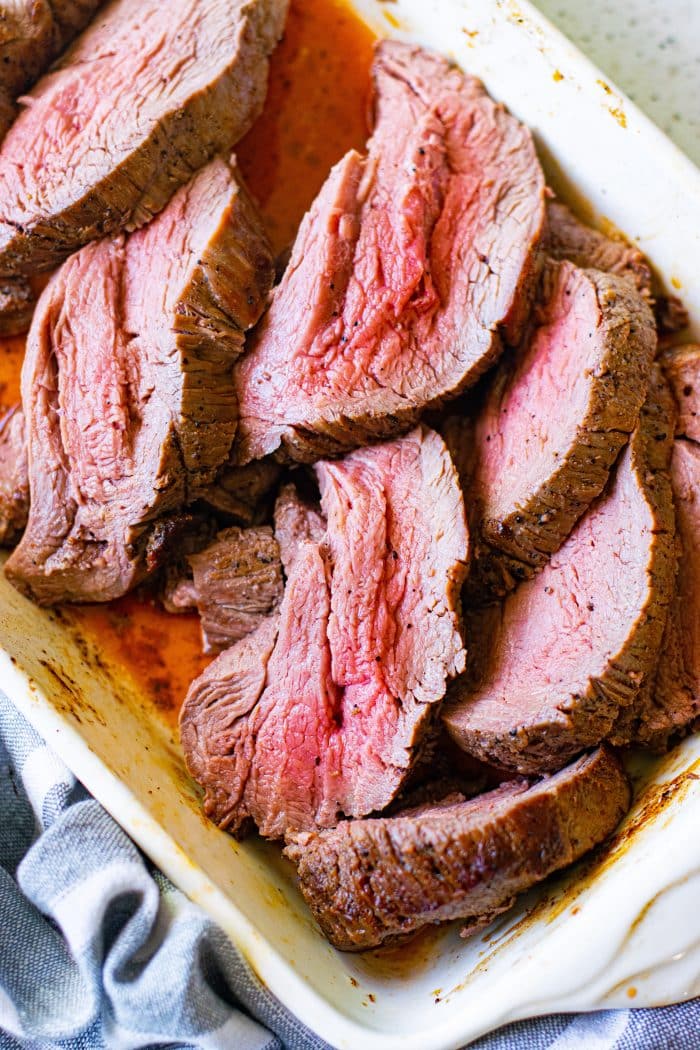
Roast Beef Tenderloin with Red Wine Sauce Recipe
Ingredients
Roast Beef Tenderloin
- 5 lb beef tenderloin, trimmed
- 1 tablespoon kosher salt
- ½ tablespoon black pepper
- 4 tablespoon butter, softened
- 1 tablespoon olive oil
Red Wine Sauce
Instructions
Roast Beef Tenderloin
- If you plan to chill your tenderloin overnight: Remove the tenderloin from the refrigerator and pat dry with paper towels. Season with salt and pepper and tie the roast with kitchen twine spaced approximately 1-inch apart (see notes). Chill in the refrigerator uncovered for at least 12 hours or overnight. Remove at least 1 hour before roasting to get the tenderloin to room temperature.
- If you do not plan to marinate overnight: Remove tenderloin from the refrigerator at least 1 hour before you plan to cook and allow it to rest at room temperature. Tie up the tenderloin and season with salt and pepper.
- Preheat the oven to 430 F / 220 C and place the baking rack in the middle of the oven.
- Meanwhile, place the room temperature tenderloin in a roasting pan and rub the softened butter all over the beef (if your beef is too cold the butter will solidify).
- Heat a large cast-iron skillet over medium-high heat. Once the pan is hot, add a tablespoon of oil and sear the tenderloin on all 4 sides, approximately 3 minutes on each side, or until golden brown.
- Transfer the seared tenderloin back to the roasting pan (reserve the cast-iron skillet, we'll be using that again in a minute) or a baking sheet and place the seared tenderloin in the preheated oven.
- Cook to your desired doneness (rare, medium-rare, or medium). It will take approximately 20 minutes to reach an internal temperature between 120 – 125 °F (medium-rare) as read using a digital meat thermometer.
- Remove the roast and allow it to rest for about 15 minutes before slicing.
- Serve with the red wine sauce (recipe instructions below).
Red Wine Sauce
- Return the cast-iron skillet to medium heat. Add a splash of red wine (just to start) to deglaze the stuck-on brown bits.
- Heat the olive oil and sauté the onion for about 3-5 minutes until soft and lightly browned. Add the garlic and sauté for an additional 1-2 minutes.
- Pour in the remaining red wine and beef broth. Add the fresh thyme. Cook until reduced by half.
- Remove the thyme sprigs and season with salt and pepper, to taste.
Notes
- As written, this recipe is gluten-free.
- If you aren’t sure how to tie your own beef tenderloin, ask the butcher at your local grocery store to do it for you. In my experience, they have always been happy to help.
- Chilling in the refrigerator overnight is optional. Doing so helps give an extra crispy sear (and is a great way to get a headstart on prep if you plan to serve this for a dinner party or special celebration).
- Regardless of if you chill your tenderloin in the refrigerator or not, be sure to remove from the refrigerator and bring to room temperature at least 1-2 hours before cooking.
- You may use salted or unsalted butter (I prefer salted)
- Optional – season the butter with a few cloves of minced garlic, horseradish sauce, dijon, or fresh herbs like fresh rosemary or thyme, if desired.
- Serving ideas: mashed potatoes, garlic roasted potatoes, roasted asparagus, roasted Brussels sprouts, roasted green beans, etc.
- Rare – 115°F – 120°F
- Medium rare – 120°F – 125°F
- Medium – 130°F – 135°F
Nutrition
Nutrition information is automatically calculated, so should only be used as an approximation.
